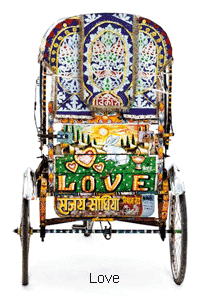- Guest Editor’s Column
- Hard Talk
- All Roads Lead to Delhi's New Art Street
- Art Nouveau : New Art Furniture
- Book Review
- Visualising Sastriya Music :
- Jamini Roy's Conviction & Marketing Strategy
- In the News
- The month that was
- Art's eye-view
- Art Bengaluru
- Photographing Rickshaws through Theatrical Eyes
- The Newspaper, the Text & the Critique
- Artist Index and Statistics
- Market Insight
- Auction Reports : What happened
- Auction Reports : what's forthcoming
- Dakshin Paschim
- Progress of Non-Abstract Geometry
- Indian Life and Landscape by Western Artists
- Recent Works by Prabhavathi Meppayil
- April Salon
- In Transition: New Art from India
- Modern Folk
- Nothing Lost in Transition
- Different hues of Aakriti
- Sotheby’s : Important Watches
ART news & views
Photographing Rickshaws through Theatrical Eyes
Volume: 2 Issue No: 4 Month: 5 Year: 2010
Rickshaws pulled by men in India have always been very intriguing for foreigners and an area of quest to understand and evaluate why and how such manually pulled vehicles still contribute to a major means of transportation in this part of the globe. Thus artists, writers and photographers  from different countries of Europe and America have picked up this subject on men pulling rickshaws from different perspectives in executing their creative works. Similarly Greg Vore, a still life photographer from Williamsburg, Brooklyn, New York has worked at length photographing on this subject completely with a new outlook and unique perception.
from different countries of Europe and America have picked up this subject on men pulling rickshaws from different perspectives in executing their creative works. Similarly Greg Vore, a still life photographer from Williamsburg, Brooklyn, New York has worked at length photographing on this subject completely with a new outlook and unique perception.
A graduate in acting and direction from Duke University, New World School of Arts and the North Carolina School of the Arts, for Greg looking at rickshaws through theatrical eyes was though innovative but quite plausible and obvious. This is exactly what he did over four years photographing rickshaws and rickshaw pullers of India and Bangladesh. He visited India thrice and photographed over hundred rickshaws in four cities. And now around twenty such photographs are being showcased at Winston-Salem's 5ive & 40rty gallery in Winston-Salem, North Carolina from April 9 through May 15, 2010.
Greg in these photographs has created a panoramic stage to orchestrate the rickshaws with their grandeur of designs,  colours and graphics as well as graffiti. He has in fact documented the rickshaws and their drivers by illuminating the individual driver's personality in vivid colour and through the saturated and ornate lacquer embellishments of how they decorate each vehicle. In this process of the theatrical representation of rickshaws, he has maneuvered the very indigenous means of transportation with an enhanced spirit and beautiful ornamentation as if the space where the rickshaw has been kept in a dream plane. Sometimes his photographs also reveal out the installation display quality.
colours and graphics as well as graffiti. He has in fact documented the rickshaws and their drivers by illuminating the individual driver's personality in vivid colour and through the saturated and ornate lacquer embellishments of how they decorate each vehicle. In this process of the theatrical representation of rickshaws, he has maneuvered the very indigenous means of transportation with an enhanced spirit and beautiful ornamentation as if the space where the rickshaw has been kept in a dream plane. Sometimes his photographs also reveal out the installation display quality.
Most of the images are completely isolated from the actual environment where they are standing or on wheels rather placed on a white, seamless backdrop that serves to focus on the art and architecture of the rickshaw by removing it from the surrounding chaos that often obscures the folk art tradition. These images are recreated as theatrical portraits of the rickshaws and the rickshaw pullers in a very simplistic manner just with a little bit of the curtain to reveal the anachronistic theatrical event of the photography itself. Greg's discourse of photography on this pretty common subject leaves the audience completely with a novel approach and an unprecedented anecdote of indigenous rickshaw and its pullers which is so beautiful and grand that the pain and pangs along with humiliation associated with this profession gets dismissed. Probably an alien eye can breed such innovation without bearing the inherent subjectivity of the native history.